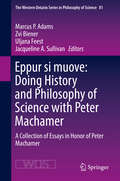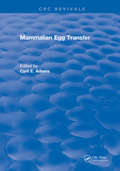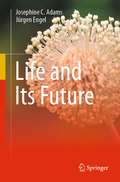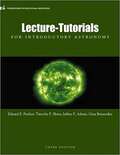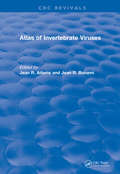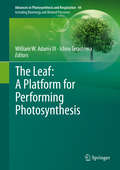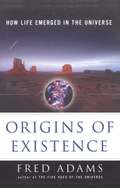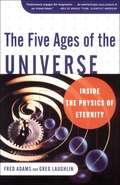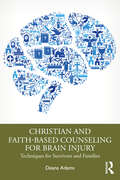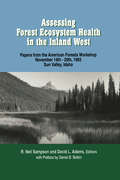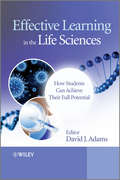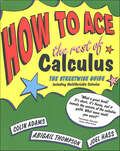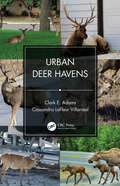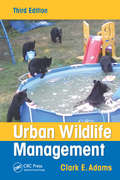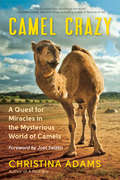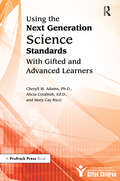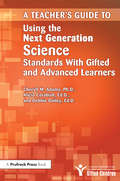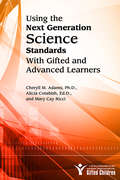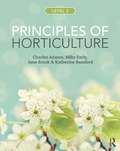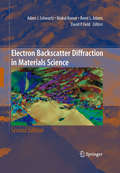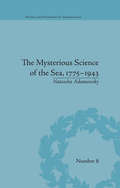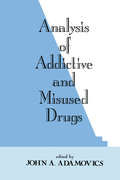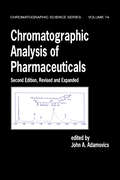- Table View
- List View
Eppur si muove: Doing History and Philosophy of Science with Peter Machamer
by Marcus P. Adams Zvi Biener Uljana Feest Jacqueline A. SullivanThis volume is a collection of original essays focusing on a wide range of topics in the History and Philosophy of Science. It is a festschrift for Peter Machamer, which includes contributions from scholars who, at one time or another, were his students. The essays bring together analyses of issues and debates spanning from early modern science and philosophy through the 21st century. Machamer's influence is reflected in the volume's broad range of topics. These include: underdetermination, scientific practice, scientific models, mechanistic explanation in contemporary and historical science, values in science, the relationship between philosophy and psychology, experimentation, supervenience and reductionism.
Mammalian Egg Transfer
by Lewis AdamsEgg transfer was first performed in 1890, but for half a century it received scant attention. However, since 1950 the technique has become increasingly widely used - in the laboratory for fundamental studies and more recently in practice, both veterinary and medical, to boost reproductive potential of genetically superior cattle and to overcome sterility due to impaired rubal function in women. As a result, a considerable body of literature has accumulated, totaling well in excess of a thousand references. But till now there has not been a single comprehensive text devoted solely to this subject. The present work was designed to meet that need at a time when the field is fast expanding with new techniques and approaches constantly being evolved. One need only cite the tremendous rate of progress in human egg transfer in the last three years. The work embraces laboratory and farm animals and primates, including man, altogether representing a total of 16 species.
Life and Its Future
by Josephine C. Adams Jürgen EngelThis book is aimed at those who wish to understand more about the molecular basis of life and how life on earth may change in coming centuries. Readers of this book will gain knowledge of how life began on Earth, the natural processes that have led to the great diversity of biological organisms that exist today, recent research into the possibility of life on other planets, and how the future of life on earth faces unprecedented pressures from human-made activities. Readers will obtain a perspective on the potential risks of chemical or nuclear warfare, and the ever-increasing risks from human activities that are causing pollution and climate change with global heating. Readers will also learn about ongoing research efforts to generate “designer lifeforms” through synthetic biology and applications of artificial intelligence. The book makes an integrated, up-to-date, overview of topics often considered as separate fields. It should be valuable to students, teachers, and people who are concerned about the future of life.
Lecture-Tutorials for Introductory Astronomy
by Jeff Adams Gina Brissenden Edward Prather Tim SlaterLecture-Tutorials for Introductory Astronomy provides a collection of 44 collaborative learning, inquiry-based activities to be used with introductory astronomy courses. Based on education research, these activities are “classroom ready” and lead to deeper, more complete understanding through a series of structured questions that prompt you to use reasoning and identify and correct their misconceptions. All content has been extensively field tested and six new tutorials have been added that respond to reviewer demand, numerous interviews, and nationally conducted workshops.
Atlas of Invertebrate Viruses: Atlas Of Invertebrate Viruses (1991) (CRC Press Revivals)
by Jean R. Adams Jean R. BonamiThe Purpose of this book is to provide a helpful reference for invertebrate pathologist, virologists, and electron microscopists on invertebrate viruses. Investigators from around the world have shared their expertise in order introduce scientists to the exciting advances in invertebrate virology.
The Leaf: A Platform for Performing Photosynthesis (Advances in Photosynthesis and Respiration #44)
by William W. Adams III Ichiro TerashimaThe leaf is an organ optimized for capturing sunlight and safely using that energy through the process of photosynthesis to drive the productivity of the plant and, through the position of plants as primary producers, that of Earth’s biosphere. It is an exquisite organ composed of multiple tissues, each with unique functions, working synergistically to: (1) deliver water, nutrients, signals, and sometimes energy-rich carbon compounds throughout the leaf (xylem); (2) deliver energy-rich carbon molecules and signals within the leaf during its development and then from the leaf to the plant once the leaf has matured (phloem); (3) regulate exchange of gasses between the leaf and the atmosphere (epidermis and stomata); (4) modulate the radiation that penetrates into the leaf tissues (trichomes, the cuticle, and its underlying epidermis); (5) harvest the energy of visible sunlight to transform water and carbon dioxide into energy-rich sugars or sugar alcohols for export to the rest of the plant (palisade and spongy mesophyll); and (6) store sugars and/or starch during the day to feed the plant during the night and/or acids during the night to support light-driven photosynthesis during the day (palisade and spongy mesophyll). Various regulatory controls that have been shaped through the evolutionary history of each plant species result in an incredible diversity of leaf form across the plant kingdom. Genetic programming is also flexible in allowing acclimatory phenotypic adjustments that optimize leaf functioning in response to a particular set of environmental conditions and biotic influences experienced by the plant. Moreover, leaves and the primary processes carried out by the leaf respond to changes in their environment, and the status of the plant, through multiple regulatory networks over time scales ranging from seconds to seasons. This book brings together the findings from laboratories at the forefront of research into various aspects of leaf function, with particular emphasis on the relationship to photosynthesis.
Origins of Existence
by Fred C. Adams Ian SchoenherrIn Origins of Existence astrophysicist Fred Adams takes a radically different approach from the long tradition of biologists and spiritual leaders who have tried to explain how the universe supports the development of life. He argues that life followed naturally from the laws of physics -- which were established as the universe burst into existence at the big bang. Those elegant laws drove the formation of galaxies, stars, and planets -- including some like our Earth. That chain of creation produced all the tiny chemical structures and vast celestial landscapes required for life. Ultimately, physical laws and the complexity they generate define the kind of biospheres that are possible -- from an Amazon rain forest to a frigid ocean beneath an ice sheet on a Jovian moon. Adams suggests that life was not merely some lucky break, but rather a natural outcome of the ascending ladder of complexity supported by our universe. Since our galaxy seems to harbor millions of planets with the same basic elements of habitability as Earth, the emergence of life is probably not a rare event. If life emerges deep inside planets and moons, as new research suggests happened on our planet, the number of viable habitats is truly enormous. Seven chronological chapters take the reader from the laws of physics and birth of the universe to the origins of life on Earth -- showing how energy flowed, exploded, and was repeatedly harnessed in replicating structures and organisms. In his groundbreaking first book, Fred Adams established the five eras of the universe with a focus on its long-term future. It is perhaps not surprising that he now turns his attention to the mystery of our astronomical origins. Here is a stunning new perspective, a book of genesis for our time, revealing how the laws of physics created galaxies, stars, planets, and even life in the universe.
The Five Ages of the Universe: Inside the Physics of Eternity
by Fred C. Adams Greg LaughlinA Simon & Schuster eBook. Simon & Schuster has a great book for every reader.
Origins of Existence: How Life Emerged in the Universe
by Fred AdamsIn his groundbreaking first book, "Five Ages of the Universe, " Adams established the five eras of the universe from birth to demise. Now, he gives readers a stunning new perspective on how the laws of physics created a nonrandom universe and life itself.
Christian and Faith-based Counseling for Brain Injury: Techniques for Survivors and Families
by Deana AdamsChristian and Faith-based Counseling for Brain Injury is the first book of its kind to offer faith-based therapy to address the emotional, cognitive, and mental health needs of individuals who have suffered a traumatic brain injury (TBI). A highly researched piece of work, the book puts forth an innovative and effective method for not only addressing the challenges of a life-changing injury but also for creating a sense of purpose. Through the nuances of faith-based counselling, this book focuses on the spiritual and existential aspects of understanding the diagnosis and creating a purpose post-injury. It examines how brain injury can affect an individual by exploring the deficits of brain injury, the impact of brain injury, and the challenges specific to damage to certain brain lobes. It also describes the mental health issues, such as depression, anxiety, grief, anger, and posttraumatic stress, that can affect both the survivor and their family members. Offering targeted counseling techniques and adaptive strategies, it shows how faith-based counselors can effectively treat brain injury. This book is valuable reading for all individuals invested in providing support to the TBI community. It is aimed at counselors, lay counselors, healthcare professionals, social workers, psychotherapists, seminary students, and upper-level graduate students. It will further be of use to for clinicians working in the outpatient level of care and private practice settings.
Assessing Forest Ecosystem Health in the Inland West
by David L. AdamsInland West, their historical origins, assessments of available management tools, and analyses of the various choices available to policymakers. Its goal is to help people understand the Inland West forests so that public policies can reflect a constructive and realistic framework in which forests can be managed for sustained health. This resource is the product of a scientific workshop where 35 participants, including scientists, resource managers, administrators, and environmentalists, addressed the forest health problem in the Inland West. Synthesis chapters integrate the diverse knowledge and experience which participants brought to the workshop. They identify and link together many of the ecological, social, and administrative conditions which have created the forest health problem in the West. The book is unique in that it reflects a process that fostered the use of academic research, field realities, and industrial knowledge to define an interdisciplinary problem, establish rational policy objectives, and set-up “do-able” management approaches.The following topics are analyzed: Assessing forest ecosystem health in the Inland West Historical and anticipated changes in forest ecosystems in the Inland West Defining and measuring forest health Historical range of variability as a tool for evaluating ecosystem change Administrative barriers to implementing forest health problems Economic and social dimensions of the forest health problem Fire management Ecosystem and landscape management
Effective Learning in the Life Sciences
by David AdamsEffective Learning in the Life Sciences is intended to help ensure that each student achieves his or her true potential by learning how to solve problems creatively in laboratory, field or other workplace setting. Each chapter describes state of the art approaches to learning and teaching and will include case studies, worked examples and a section that lists additional online and other resources.All of the chapters are written from the perspective both of students and academics and emphasize and embrace effective scientific method throughout. This title also draws on experience from a major project conducted by the Centre for Bioscience, with a wide range of collaborators, designed to identify and implement creative teaching in bioscience laboratories and field settings.With a strong emphasis on students thinking for themselves and actively learning about their chosen subject Effective Learning in the Life Sciences provides an invaluable guide to making the university experience as effective as possible.
How to Ace the Rest of Calculus: The Streetwise Guide (How to Ace)
by Colin Adams Abigail Thompson Joel HassThe sequel to How to Ace Calculus, How to Ace the Rest of Calculus provides humorous and highly readable explanations of the key topics of second and third semester calculus-such as sequences and series, polor coordinates, and multivariable calculus-without the technical details and fine print that would be found in a formal text.
Urban Deer Havens
by Clark E. Adams Cassandra LaFleur VillarrealUrban Deer Havens consists of a thorough examination of selected cervid (deer) species that are known to inhabit urban communities in the United States. The deer species that are included in this presentation consisted of white-tailed (Odocoileus virginianus), Key deer (O. v. clavium), moose (Alces alces), elk (Cervus elaphus), mule (Odocoileus hemionus), and black-tailed deer (O. h. columbianus). This book is the first attempt to examine the similarities and differences in those factors that allow the selected cervids to exist and thrive in urban habitats. This information has never been collected, collated, reviewed, and published under one cover document. Yet, all five are known to inhabit urban communities within their geographic range. The lack of information concerning several important examples of urban cervids in conjunction with a proliferation of information on white-tailed deer only is an incomplete and biased presentation. This book is the first comprehensive source of information on urban deer management, which includes a broad assemblage of urban cervids. The overall objective of this book is to provide a more holistic examination of urban cervids. For example, it examines the similarities and differences of the environmental impacts, management strategies, and human dimensions considerations concerning urban cervids in general, and using specific examples. Urban Deer Havens features four chapters that include: Urban deer census techniques and population dynamics Comprehensive tables that review urban community deer management plans National and state-wide estimates the five selected cervids Laws and regulations concerning urban deer Lethal and nonlethal management options for managing deer Steps for managing urban deer populations Examples of urban deer management efforts
Urban Wildlife Management
by Clark E. AdamsWinner of the 2018 TWS Wildlife Publication Awards in the authored book category Urban development is one of the leading worldwide threats to conserving biodiversity. In the near future, wildlife management in urban landscapes will be a prominent issue for wildlife professionals. This new edition of Urban Wildlife Management continues the work of its predecessors by providing a comprehensive examination of the issues that increase the need for urban wildlife management, exploring the changing dynamics of the field while giving historical perspectives and looking at current trends and future directions. The book examines a range of topics on human interactions with wildlife in urbanized environments. It focuses not only on ecological matters but also on political, economic, and societal issues that must be addressed for successful management planning. This edition features an entirely new section on urban wildlife species, including chapters on urban communities, herpetofauna, birds, ungulates, mammals, carnivores, and feral and introduced species. The third edition features Five new chapters 12 updated chapters Four new case studies Seven new appendices and species profiles 90 new figures A comprehensive analysis of terrestrial vertebrate locations by state and urban observations Each chapter opens with a set of key concepts which are then examined in the following discussions. Suggested learning experiences to enhance knowledge conclude each chapter. The species profiles cover not only data about the animal concerned but also detail significant current management issues related to the species. An updated and expanded teaching tool, Urban Wildlife Management, Third Edition identifies the challenges and opportunities facing wildlife in urban communities as well as factors that promote or threaten their presence. It gives both students and professionals a solid grounding in the required fundamental ecological principles for understanding the effects of human-made environments on wildlife.
Camel Crazy: A Quest for Miracles in the Mysterious World of Camels
by Christina AdamsIn this page-turning odyssey, a mother on a mission travels the globe — from Bedouin camps in the Middle East to Amish farms in Pennsylvania to camel-herder villages in India — to obtain camel milk, which dramatically helps her son’s autism symptoms. Chronicling bureaucratic roadblocks, adventure-filled detours, and Christina Adams’s love-fueled determination, Camel Crazy explores why camels are cherished as family members and hailed as healers. Adams’s work uncovers studies of camel milk for possible treatment of autism, allergies, diabetes, and immune dysfunction, as well as ancient traditions of healing. But the most fascinating aspect of Adams’s discoveries is the gentle-eyed, mischievous camels themselves. Huge and often unpredictable, they are amazingly intelligent and adaptable. This moving and rollicking ode to “camel people” and the creatures they adore reveals the ways camels touch lives around the world. Includes users’ and buyers’ guides to camel’s milk
Using the Next Generation Science Standards With Gifted and Advanced Learners
by Cheryll M. Adams Alicia Cotabish Mary RicciUsing the Next Generation Science Standards With Gifted and Advanced Learners provides teachers and administrators examples and strategies to implement the Next Generation Science Standards (NGSS) with gifted and advanced learners at all stages of development in K-12 schools. The book describes—and demonstrates with specific examples from the NGSS—what effective differentiated activities in science look like for high-ability learners. It shares how educators can provide rigor within the new standards to allow students to demonstrate higher level thinking, reasoning, problem solving, passion, and inventiveness in science. By doing so, students will develop the skills, habits of mind, and attitudes toward learning needed to reach high levels of competency and creative production in science fields.
Teacher's Guide to Using the Next Generation Science Standards With Gifted and Advanced Learners
by Cheryll M. Adams Alicia Cotabish Debbie DaileyA Teacher's Guide to Using the Next Generation Science Standards With Gifted and Advanced Learners provides teachers and administrators with practical examples of ways to build comprehensive, coherent, and rigorous science learning experiences for gifted and advanced students from kindergarten to high school. It provides an array of examples across the four domains of science: physical sciences; Earth and space sciences; life sciences; and engineering, technology, and applications of science. Each learning experience indicates the performance expectation addressed and includes a sequence of activities, implementation examples, connections to the CCSS-Math and CCSS-ELA, and formative assessments. Chapters on specific instructional and management strategies, assessment, and professional development suggestions for implementing the standards within the classroom will be helpful for both teachers and administrators.
Using the Next Generation Science Standards With Gifted and Advanced Learners
by Cheryll M. Adams Alicia Cotabish Ed. D. Mary Cay RicciUsing the Next Generation Science Standards With Gifted and Advanced Learners provides teachers and administrators examples and strategies to implement the Next Generation Science Standards (NGSS) with gifted and advanced learners at all stages of development in K?12 schools. The book describes-and demonstrates with specific examples from the NGSS-what effective differentiated activities in science look like for high-ability learners. It shares how educators can provide rigor within the new standards to allow students to demonstrate higher level thinking, reasoning, problem solving, passion, and inventiveness in science. By doing so, students will develop the skills, habits of mind, and attitudes toward learning needed to reach high levels of competency and creative production in science fields.
Principles of Horticulture: Level 2
by Charles Adams Mike Early Jane Brook Katherine BamfordThis colourful guide will introduce you to the fundamentals of horticulture, whether you are taking a Level 2 RHS, City and Guilds or BTEC course, are a keen amateur or seasoned gardener. Written in a clear and accessible style, this book covers the principles that underpin growing plants for the garden and on the allotment, with reference to how these are tackled by professionals. With highlighted definitions, key points, and illustrated in full colour, this book will be a useful companion as you progress in the study and practice of horticulture. Complete with a companion website which includes extended horticultural information, questions and exercises to test your knowledge, syllabus cross-referencing and downloadable tutor and student support materials. Available at www.routledge.com/cw/adams
Electron Backscatter Diffraction in Materials Science
by Brent L. Adams Mukul Kumar Adam J. Schwartz David P. FieldElectron backscatter diffraction is a very powerful and relatively new materials characterization technique aimed at the determination of crystallographic texture, grain boundary character distributions, lattice strain, phase identification, and much more. The purpose of this book is to provide the fundamental basis for electron backscatter diffraction in materials science, the current state of both hardware and software, and illustrative examples of the applications of electron backscatter diffraction to a wide-range of materials including undeformed and deformed metals and alloys, ceramics, and superconductors. The text has been substantially revised from the first edition, and the authors have kept the format as close as possible to the first edition text. The new developments covered in this book include a more comphrensive coverage of the fundamentals not covered in the first edition or other books in the field, the advances in hardware and software since the first edition was published, and current examples of application of electron backscatter diffraction to solve challenging problems in materials science and condensed-matter physics.
So Many Sounds (Houghton Mifflin Vocabulary Reader Accompanies Journeys)
by Ashlyn AdamsNIMAC-sourced textbook <P><P>Level F DRA 10 Science Strategy-Monitor/Clarify
The Mysterious Science of the Sea, 1775–1943 (History and Philosophy of Technoscience #8)
by Natascha AdamowskyThe depths of the oceans are the last example of terra incognita on earth. Adamowsky presents a study of the sea, arguing that – contrary to popular belief – post-Enlightenment discourse on the sea was still subject to mystery and wonder, and not wholly rationalized by science.
Analysis of Addictive and Misused Drugs
by John A. AdamovicsExamines the chromatographic and nonchromatographic methods available to identify, measure, and screen for nonmedical drug use, highlighting the latest technologies in immunochemical analysis, biosensors, thinlayer gas chromatography, high-performance liquid chromatography, and capillary electrophoresis. A comprehensive alphabetic listing of over 400 controlled-use drugs is provided.
Chromatographic Analysis of Pharmaceuticals (Chromatographic Science Ser. #74)
by John A. AdamovicsUpdated and revised throughout. Second Edition explores the chromatographic methods used for the measurement of drugs, impurities, and excipients in pharmaceutical preparations--such as tablets, ointments, and injectables. Contains a 148-page table listing the chromatographic data of over 1300 drugs and related substances--including sample matrix analyzed, sample handling procedures, column packings, mobile phase, mode of detection, and more.
